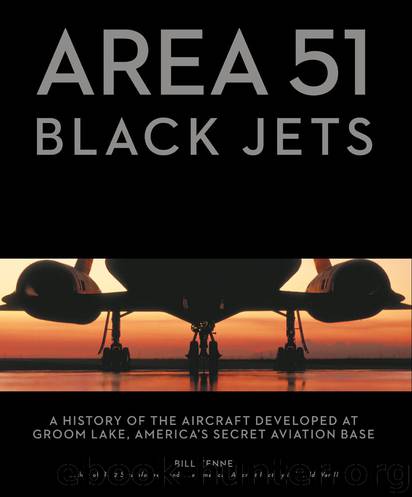Area 51, Black Jets by Bill Yenne

Author:Bill Yenne
Language: eng
Format: epub
Publisher: MBI
Published: 2014-08-10T16:00:00+00:00
During the Cold War, Blackbirds of the 9th SRW deployed around the world from their stateside base at Beale AFB. USAF, Tech Sergeant Michael Haggerty
Cranking up an SR-71A Blackbird for launch from Beale AFB in California in June 1983. Bill Yenne
Despite the retrofitting of digital systems and communications links aboard the SR-71s, which allowed them to deliver imagery in near “real time,” the US Air Force itself recommended the retirement of the Blackbirds.
“General Larry Welch, the Air Force chief of staff, staged a one-man campaign on Capitol Hill to kill the program entirely,” Ben Rich wrote in his memoirs. “General Welch thought sophisticated spy satellites made the SR-71 a disposable luxury. Welch had headed the Strategic Air Command and was partial to its priorities. He wanted to use SR-71 refurbishment funding for development of the B-2 bomber. He was quoted by columnist Rowland Evans as saying, ‘The Blackbird can’t fire a gun and doesn’t carry a bomb, and I don’t want it.’ Then the general went on the Hill and claimed to certain powerful committee chairmen that he could operate a wing of fifteen to twenty [F-15E] fighter-bombers with what it cost him to fly a single SR-71. That claim was bogus. So were claims by SAC generals that the SR-71 cost $400 million annually to run. The actual cost was about $260 million.”
Both Welch and SAC commander General John Chain testified before Congress that the SR-71 should go, and so it did.
As Rich so aptly reflected, “a general would always prefer commanding a large fleet of conventional fighters or bombers that provides high visibility and glory. By contrast, buying into Blackbird would mean deep secrecy, small numbers, and no limelight.”
Blackbird operations, except training flights, were officially terminated in November 1989, having been eliminated from the FY1990 Defense Department budget.
On March 6, 1990, one Blackbird famously set a series of world speed records on its “retirement flight.” The SR-71 with tail number 64-17972 was flown from California to the Smithsonian National Air & Space Museum (NASM) Udvar-Hazy Center at Dulles Airport, where it would eventually go on display. In the process, it set the official National Aeronautic Association coast-to-coast speed record of 2,086 miles in one hour and seven minutes, averaging 2,124.5 mph. It made the 311-mile St. Louis-to-Cincinnati leg in less than nine minutes, averaging 2,176.08 mph.
Within a few months of this much-publicized flight, Saddam Hussein’s Iraqi army had occupied Kuwait and the United States was involved in the Desert Shield buildup that culminated in Operation Desert Storm in January and February 1991. During that conflict, many operational commanders, including General Norman Schwarzkopf, lamented the absence of expedited reconnaissance that the SR-71 might have contributed.
Download
This site does not store any files on its server. We only index and link to content provided by other sites. Please contact the content providers to delete copyright contents if any and email us, we'll remove relevant links or contents immediately.
Learning SQL by Alan Beaulieu(6239)
Weapons of Math Destruction by Cathy O'Neil(6220)
Digital Minimalism by Cal Newport;(5707)
iGen by Jean M. Twenge(5387)
Sapiens by Yuval Noah Harari(5325)
The Age of Surveillance Capitalism by Shoshana Zuboff(4250)
Elon Musk by Ashlee Vance(4086)
Thing Explainer by Randall Munroe(3911)
Apollo 8 by Jeffrey Kluger(3671)
Future Crimes by Marc Goodman(3566)
The Science Book (Big Ideas Simply Explained) by DK(3256)
Who Can You Trust? by Rachel Botsman(3111)
The Innovators: How a Group of Hackers, Geniuses, and Geeks Created the Digital Revolution by Walter Isaacson(3003)
I Live in the Future & Here's How It Works by Nick Bilton(2963)
Infinite Energy Technologies by Finley Eversole(2953)
Steve Jobs by Walter Isaacson(2863)
Dawn of the New Everything by Jaron Lanier(2751)
Chernobyl by Serhii Plokhy(2516)
Ben Franklin's Almanac by Candace Fleming(2494)
